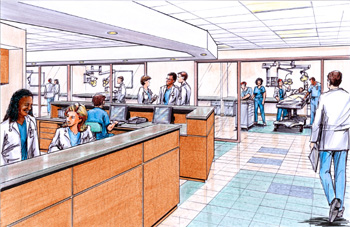
The expansion of the Emergency Department will increase exam and treatment rooms from 27 to 46.
Expansion and renovation of VUH gets under way
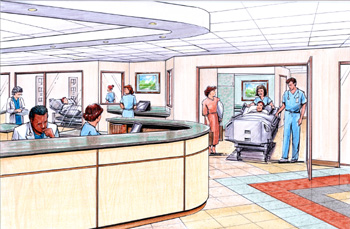
Individual rooms will be a new feature of the adult intensive care areas.
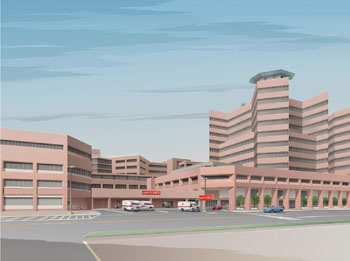
Exterior of VUH
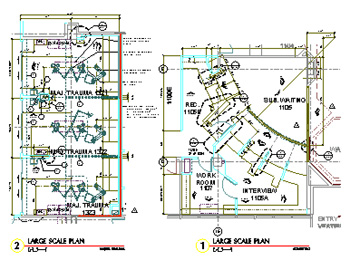
Sample plans
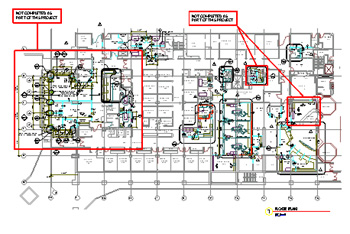
Sample Plans
A continuing focus on the transformation of Vanderbilt University Hospital
With the move to the new Vanderbilt Children’s Hospital now complete, back at Vanderbilt University Hospital the $35 million expansion of the Emergency Department and renovation of former Children’s Hospital areas is moving into full swing.
The renovation and expansion is the first phase of a multi-year project that will see the complete reconfiguration and renovation of the Vanderbilt University Hospital building, including the addition of a third bed tower over the current Emergency Department and a new unified floor plan stretching across all three towers. The overall project is expected to cost $300 million.
The first phase of reconstruction will be completed in stages over the coming 14 months. Norman B. Urmy, executive vice president for Clinical Affairs and CEO of Vanderbilt University Hospital, said, “This increased hospital capacity will help improve access to care for the community. In designing this expansion and renovation, we’ve taken care to address the changing needs of our patients, physicians and clinical teams, as well as the strategic goals of Vanderbilt Medical Center. I would like to thank our planning team for their year of hard work on this project.”
The move to Children’s Hospital has made available for redeployment floors five and six of Vanderbilt University Hospital, a portion of the fourth floor, and the suite of operating rooms on the third floor of Medical Center East.
The fifth and sixth floors of VUH will serve patients of two strategically vital VUMC clinical programs, the Cardiovascular and Neuroscience patient care centers. The floor renovations have been preceded by a year’s planning by architectural consultants, patient care center leaders and VUMC Space and Facilities Planning. Both floors will initially operate at half capacity, and will plan to open more beds as patient volume grows.
The sixth floor, which is scheduled for reopening in late March, will undergo light renovation, including new floor surfaces, new paint and cabinetry, new beds, and the addition of a nurses station and rooms for residents on overnight call at the hospital.
The more extensive fifth floor renovation will take a year to complete. All patient rooms will be demolished and rebuilt, each increasing from 175 to 300 square feet, which VUMC planners say is a size more in keeping with the market.
“The hospital renovation will allow the Neurology and Neurosurgery departments to expand faculty and clinical practice and advance greatly our joint programs for movement disorders, epilepsy, stroke and neuro-oncology,” said Dr. George S. Allen, professor and chair of Neurosurgery.
VUMC Neurosciences departments have grown rapidly in recent years. Allen said Neurosurgery will add four more faculty by July 2004, and Dr. Robert L. Macdonald, professor and chair of Neurology, said his department will add another 10 faculty within two years.
Neurosciences will be allocated 28 beds on 6 North and 22 intensive care beds on 5 South.
The Cardiovascular Patient Care Center, which takes in everything from general cardiology to thoracic surgery, will be allocated 17 step-down beds on 6 South and 28 intensive care beds on 5 North.
The plan for later phases of the rebuilding project calls for the Cardiovascular and Neurosciences patient care centers to each be consolidated on a single floor of the hospital.
“Our idea is that this renovation will be a bridge to a whole new way of working, to a cardiovascular center inside the hospital that will be a model for other programs around the country,” said Dr. Keith B. Churchwell, assistant clinical professor of Medicine and director of the Vanderbilt Page-Campbell Heart Institute. He said the theme of the new center will be greater standardization of cardiovascular care according to the principles of evidence-based medicine. “We’ve made tremendous strides over the past 10 years in standardizing the care of cardiovascular patients at VUMC, but current space limitations have tended to make these efforts somewhat piecemeal. The renovation is a great opportunity to take all we’ve learned and apply it to a program that will be built from the ground up,” Churchwell said.
Robin L. Steaban, the center’s administrative director, said, “One of the main aids to standardization of care will be greater specialization of our nursing staff; this specialization is difficult today because these patients tend to be dispersed in different areas of the hospital.”
For bypass surgery and heart attack patients, 6 South will include a room with treadmills, stationary bikes and monitoring equipment for initiating patient rehabilitation during hospital admission. “Our current practice of walking these patients in VUH hallways is only a stopgap,” Steaban said.
ED Expansion
The current Emergency Department was built to handle an annual volume of 20,000 visits. Today the adult ED sees more than 42,000 visits per year. The expansion will increase Emergency Department exam and treatment rooms from 27 to 46.
“Increased volume, a need for more critical care treatment areas, and growing observation times all factored into the decision to begin the expansion process,” explained Dr. Corey M. Slovis, professor and chairman of Emergency Medicine. “We have a number of problems in the main ED with space and layout that affect how we do our jobs. It was designed in the 1970s and built in 1980 and was envisioned to be a clinic and walk-in area for a university hospital, not the home of a regional trauma center.”
Vanderbilt is the only Level One trauma center in the Middle Tennessee region and hosts the only emergency medicine residency in Tennessee. Physicians in the ED serve as medical control for Vanderbilt’s LifeFlight program, which flies more than 1,800 missions per year.
Construction began in January beside the current Emergency Department, expanding it out into a current parking and ambulance parking area. Cost for the new Emergency Department is estimated between $8.5 and $13.5 million and will take as long as 14 months to complete.
The current ED will be remodeled and utilized for less critical “fastrack” patients, 23-hour observation, chest pain, stroke patients and ob/gyn patients.
The new ED will have a greatly expanded waiting room for family and visitors, four trauma suites (equipped with operating room-quality lighting and medical gasses that drop from the ceiling), a new hazardous materials decontamination area, an EMS work area, storage for stretchers, a conference and teaching center and a chest pain and stroke center.
“We might see some increase in staff, but the entire area will be much more efficient,” said Dr. Ian Jones, assistant professor in Emergency Medicine and director of the Adult Emergency Department. “And we’ll have state-of-the-art equipment. It will be an emergency department that Vanderbilt and Nashville will be proud of.”
One of the biggest challenges during construction of the new Emergency Department will be to reroute patient arrivals. The front of the new area will provide a drop off point for patients arriving by car, and ambulances will back up to bays to unload patients. Vanderbilt Police will provide 24-hour coverage in the area during construction to help with traffic flow.













